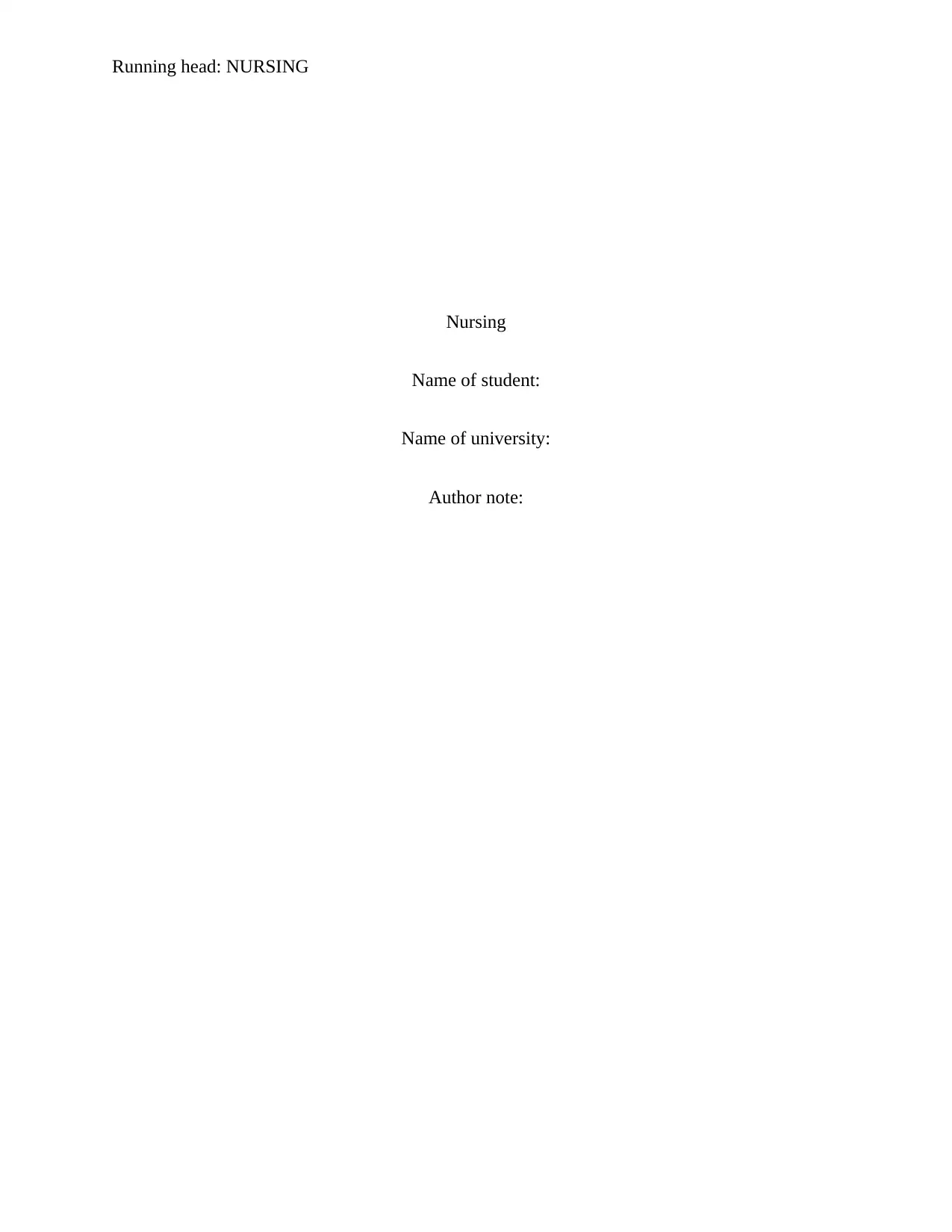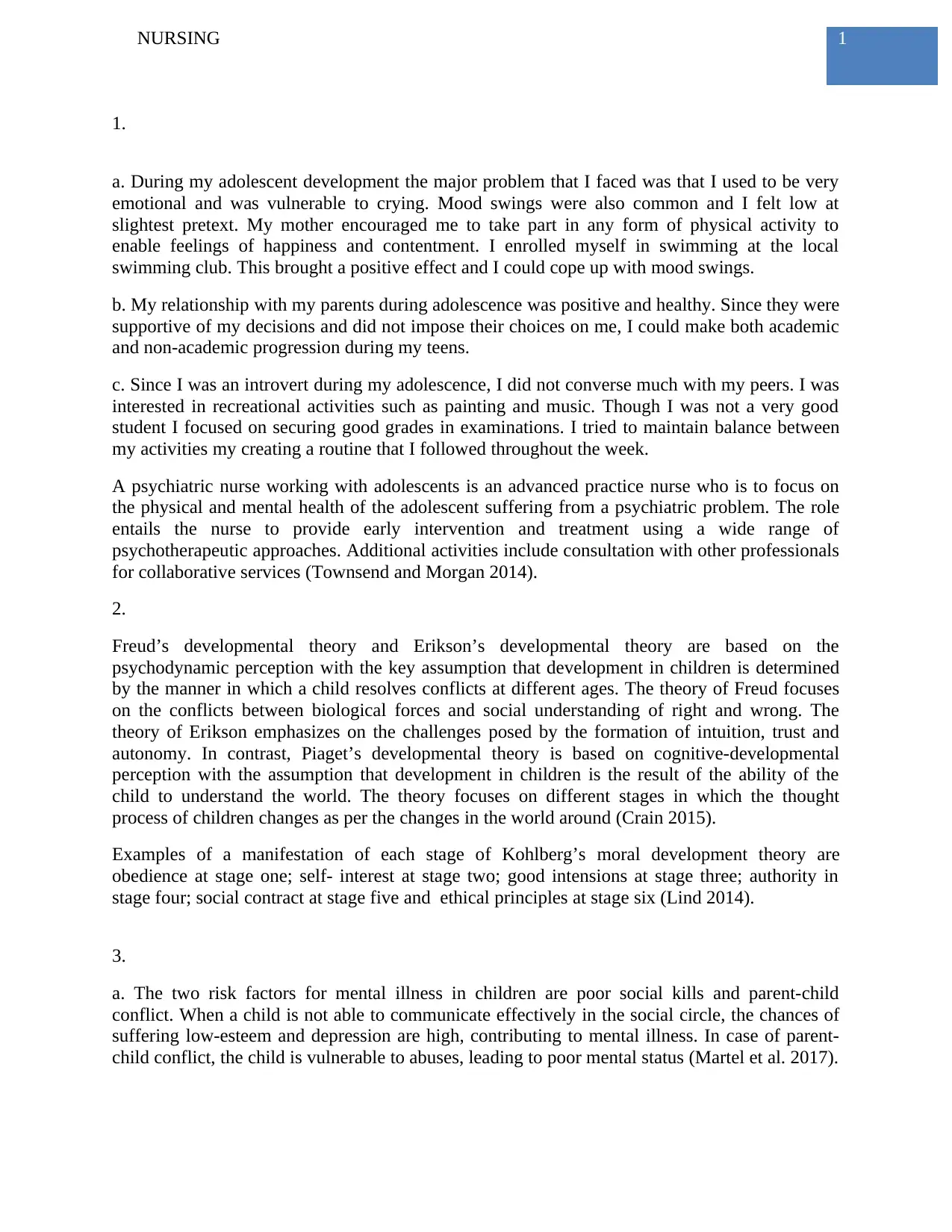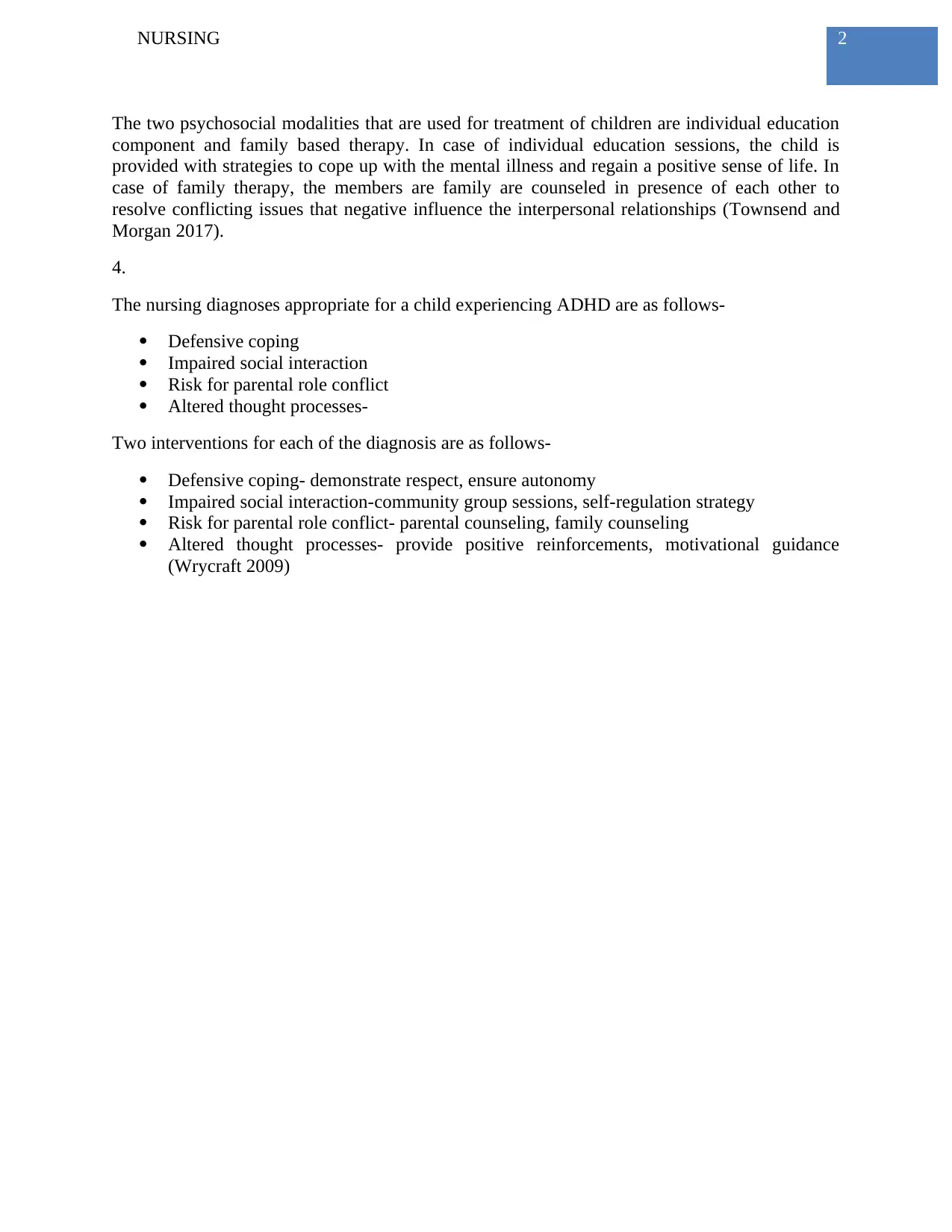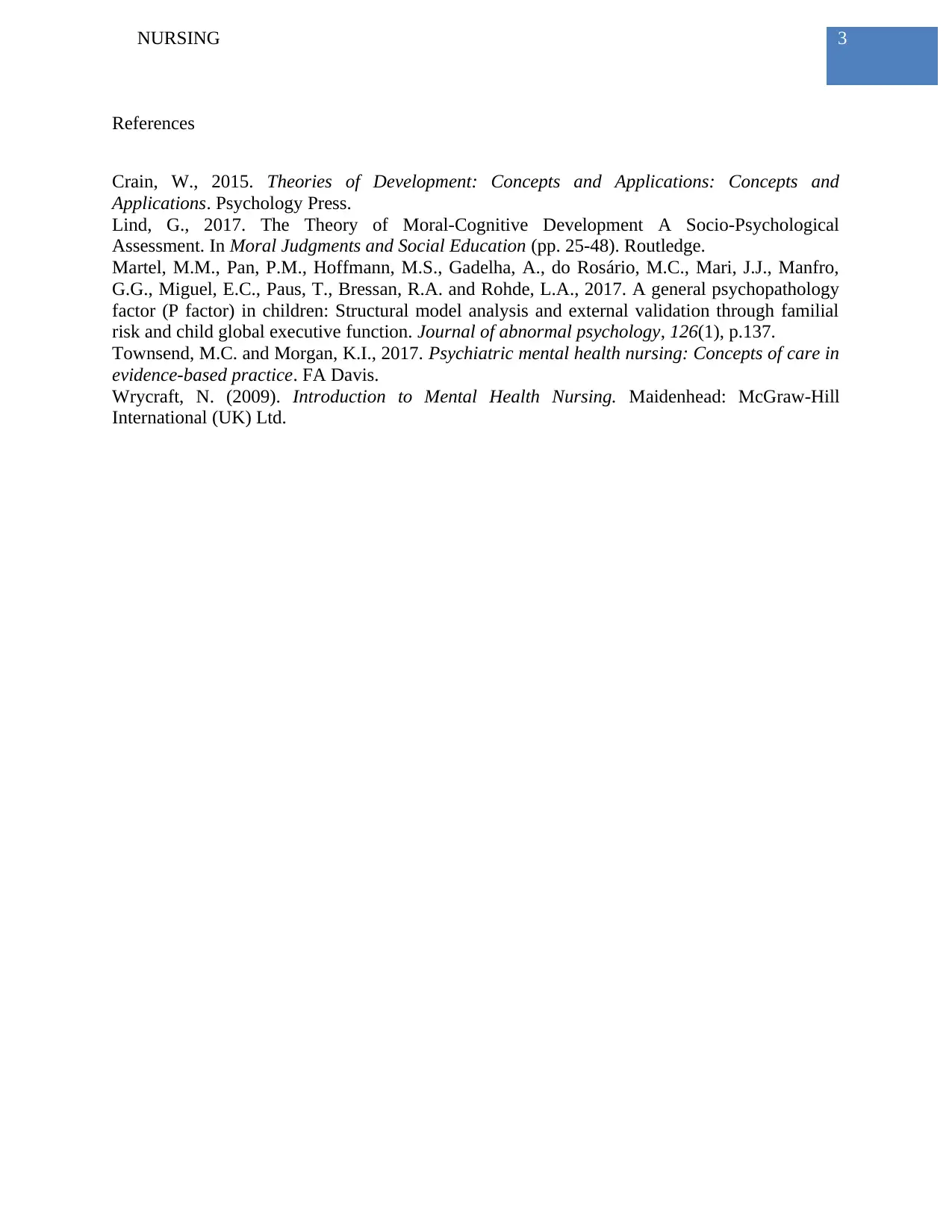Nursing Assignment: Adolescent Mental Health and Nursing Care
VerifiedAdded on 2023/06/10
|4
|899
|313
Homework Assignment
AI Summary
This nursing assignment explores various aspects of adolescent mental health, including personal experiences during adolescence, the role of a psychiatric nurse, and the application of developmental theories. The assignment delves into risk factors associated with mental illness in children, such as poor social skills and parent-child conflict, and discusses psychosocial modalities for treatment, including individual education and family-based therapy. Furthermore, it addresses nursing diagnoses and interventions for children with ADHD, offering practical strategies for managing symptoms and promoting well-being. The assignment also includes references to relevant literature to support the analysis and recommendations.

Running head: NURSING
Nursing
Name of student:
Name of university:
Author note:
Nursing
Name of student:
Name of university:
Author note:
Paraphrase This Document
Need a fresh take? Get an instant paraphrase of this document with our AI Paraphraser

1NURSING
1.
a. During my adolescent development the major problem that I faced was that I used to be very
emotional and was vulnerable to crying. Mood swings were also common and I felt low at
slightest pretext. My mother encouraged me to take part in any form of physical activity to
enable feelings of happiness and contentment. I enrolled myself in swimming at the local
swimming club. This brought a positive effect and I could cope up with mood swings.
b. My relationship with my parents during adolescence was positive and healthy. Since they were
supportive of my decisions and did not impose their choices on me, I could make both academic
and non-academic progression during my teens.
c. Since I was an introvert during my adolescence, I did not converse much with my peers. I was
interested in recreational activities such as painting and music. Though I was not a very good
student I focused on securing good grades in examinations. I tried to maintain balance between
my activities my creating a routine that I followed throughout the week.
A psychiatric nurse working with adolescents is an advanced practice nurse who is to focus on
the physical and mental health of the adolescent suffering from a psychiatric problem. The role
entails the nurse to provide early intervention and treatment using a wide range of
psychotherapeutic approaches. Additional activities include consultation with other professionals
for collaborative services (Townsend and Morgan 2014).
2.
Freud’s developmental theory and Erikson’s developmental theory are based on the
psychodynamic perception with the key assumption that development in children is determined
by the manner in which a child resolves conflicts at different ages. The theory of Freud focuses
on the conflicts between biological forces and social understanding of right and wrong. The
theory of Erikson emphasizes on the challenges posed by the formation of intuition, trust and
autonomy. In contrast, Piaget’s developmental theory is based on cognitive-developmental
perception with the assumption that development in children is the result of the ability of the
child to understand the world. The theory focuses on different stages in which the thought
process of children changes as per the changes in the world around (Crain 2015).
Examples of a manifestation of each stage of Kohlberg’s moral development theory are
obedience at stage one; self- interest at stage two; good intensions at stage three; authority in
stage four; social contract at stage five and ethical principles at stage six (Lind 2014).
3.
a. The two risk factors for mental illness in children are poor social kills and parent-child
conflict. When a child is not able to communicate effectively in the social circle, the chances of
suffering low-esteem and depression are high, contributing to mental illness. In case of parent-
child conflict, the child is vulnerable to abuses, leading to poor mental status (Martel et al. 2017).
1.
a. During my adolescent development the major problem that I faced was that I used to be very
emotional and was vulnerable to crying. Mood swings were also common and I felt low at
slightest pretext. My mother encouraged me to take part in any form of physical activity to
enable feelings of happiness and contentment. I enrolled myself in swimming at the local
swimming club. This brought a positive effect and I could cope up with mood swings.
b. My relationship with my parents during adolescence was positive and healthy. Since they were
supportive of my decisions and did not impose their choices on me, I could make both academic
and non-academic progression during my teens.
c. Since I was an introvert during my adolescence, I did not converse much with my peers. I was
interested in recreational activities such as painting and music. Though I was not a very good
student I focused on securing good grades in examinations. I tried to maintain balance between
my activities my creating a routine that I followed throughout the week.
A psychiatric nurse working with adolescents is an advanced practice nurse who is to focus on
the physical and mental health of the adolescent suffering from a psychiatric problem. The role
entails the nurse to provide early intervention and treatment using a wide range of
psychotherapeutic approaches. Additional activities include consultation with other professionals
for collaborative services (Townsend and Morgan 2014).
2.
Freud’s developmental theory and Erikson’s developmental theory are based on the
psychodynamic perception with the key assumption that development in children is determined
by the manner in which a child resolves conflicts at different ages. The theory of Freud focuses
on the conflicts between biological forces and social understanding of right and wrong. The
theory of Erikson emphasizes on the challenges posed by the formation of intuition, trust and
autonomy. In contrast, Piaget’s developmental theory is based on cognitive-developmental
perception with the assumption that development in children is the result of the ability of the
child to understand the world. The theory focuses on different stages in which the thought
process of children changes as per the changes in the world around (Crain 2015).
Examples of a manifestation of each stage of Kohlberg’s moral development theory are
obedience at stage one; self- interest at stage two; good intensions at stage three; authority in
stage four; social contract at stage five and ethical principles at stage six (Lind 2014).
3.
a. The two risk factors for mental illness in children are poor social kills and parent-child
conflict. When a child is not able to communicate effectively in the social circle, the chances of
suffering low-esteem and depression are high, contributing to mental illness. In case of parent-
child conflict, the child is vulnerable to abuses, leading to poor mental status (Martel et al. 2017).

2NURSING
The two psychosocial modalities that are used for treatment of children are individual education
component and family based therapy. In case of individual education sessions, the child is
provided with strategies to cope up with the mental illness and regain a positive sense of life. In
case of family therapy, the members are family are counseled in presence of each other to
resolve conflicting issues that negative influence the interpersonal relationships (Townsend and
Morgan 2017).
4.
The nursing diagnoses appropriate for a child experiencing ADHD are as follows-
Defensive coping
Impaired social interaction
Risk for parental role conflict
Altered thought processes-
Two interventions for each of the diagnosis are as follows-
Defensive coping- demonstrate respect, ensure autonomy
Impaired social interaction-community group sessions, self-regulation strategy
Risk for parental role conflict- parental counseling, family counseling
Altered thought processes- provide positive reinforcements, motivational guidance
(Wrycraft 2009)
The two psychosocial modalities that are used for treatment of children are individual education
component and family based therapy. In case of individual education sessions, the child is
provided with strategies to cope up with the mental illness and regain a positive sense of life. In
case of family therapy, the members are family are counseled in presence of each other to
resolve conflicting issues that negative influence the interpersonal relationships (Townsend and
Morgan 2017).
4.
The nursing diagnoses appropriate for a child experiencing ADHD are as follows-
Defensive coping
Impaired social interaction
Risk for parental role conflict
Altered thought processes-
Two interventions for each of the diagnosis are as follows-
Defensive coping- demonstrate respect, ensure autonomy
Impaired social interaction-community group sessions, self-regulation strategy
Risk for parental role conflict- parental counseling, family counseling
Altered thought processes- provide positive reinforcements, motivational guidance
(Wrycraft 2009)
⊘ This is a preview!⊘
Do you want full access?
Subscribe today to unlock all pages.

Trusted by 1+ million students worldwide

3NURSING
References
Crain, W., 2015. Theories of Development: Concepts and Applications: Concepts and
Applications. Psychology Press.
Lind, G., 2017. The Theory of Moral-Cognitive Development A Socio-Psychological
Assessment. In Moral Judgments and Social Education (pp. 25-48). Routledge.
Martel, M.M., Pan, P.M., Hoffmann, M.S., Gadelha, A., do Rosário, M.C., Mari, J.J., Manfro,
G.G., Miguel, E.C., Paus, T., Bressan, R.A. and Rohde, L.A., 2017. A general psychopathology
factor (P factor) in children: Structural model analysis and external validation through familial
risk and child global executive function. Journal of abnormal psychology, 126(1), p.137.
Townsend, M.C. and Morgan, K.I., 2017. Psychiatric mental health nursing: Concepts of care in
evidence-based practice. FA Davis.
Wrycraft, N. (2009). Introduction to Mental Health Nursing. Maidenhead: McGraw-Hill
International (UK) Ltd.
References
Crain, W., 2015. Theories of Development: Concepts and Applications: Concepts and
Applications. Psychology Press.
Lind, G., 2017. The Theory of Moral-Cognitive Development A Socio-Psychological
Assessment. In Moral Judgments and Social Education (pp. 25-48). Routledge.
Martel, M.M., Pan, P.M., Hoffmann, M.S., Gadelha, A., do Rosário, M.C., Mari, J.J., Manfro,
G.G., Miguel, E.C., Paus, T., Bressan, R.A. and Rohde, L.A., 2017. A general psychopathology
factor (P factor) in children: Structural model analysis and external validation through familial
risk and child global executive function. Journal of abnormal psychology, 126(1), p.137.
Townsend, M.C. and Morgan, K.I., 2017. Psychiatric mental health nursing: Concepts of care in
evidence-based practice. FA Davis.
Wrycraft, N. (2009). Introduction to Mental Health Nursing. Maidenhead: McGraw-Hill
International (UK) Ltd.
1 out of 4
Related Documents
Your All-in-One AI-Powered Toolkit for Academic Success.
+13062052269
info@desklib.com
Available 24*7 on WhatsApp / Email
![[object Object]](/_next/static/media/star-bottom.7253800d.svg)
Unlock your academic potential
Copyright © 2020–2025 A2Z Services. All Rights Reserved. Developed and managed by ZUCOL.





